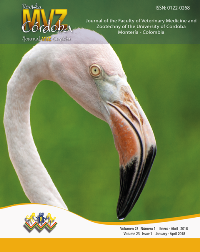Evaluation of Cardiopulmonary biomarkers during different stages of Canine Visceral Leishmaniasis
Evaluación de biomarcadores cardiopulmonares durante diferentes etapas de Leishmaniasis visceral canina
Show authors biography
Objective.The purpose of the present study was to test the hypothesis that cardiac alterations participate within different stages of CVL. Materials and methods. Dogs were diagnosed with CVL, were classified as follows; group I (mild disease), group II (moderate disease), group III (severe disease), group IV (very severe disease) and group V included healthy controls. Results. Ig G antibodies against Leishmaniasis in group as tested by IFAT, were deemed 1/64 to 1/16000 among infected groups. Considering the cTnI levels, there was significant differences (p=0.018) between stage IV (group IV) and healthy control group, besides between group IV and group I. Considering D-dimer levels, there was difference between healthy control group and group II, III and IV (p=0.005). NT-proBNP levels, there was istatistical difference between healthy control group and stage III, IV, besides between stage I with stage III, IV (p=0.000). Conclusions. The results showed that levels of cTnI, Nt pro-BNP and D-dimer were higher in dogs infected with CVL in contrast to healthy dogs, in which levels of those biomarkers were below detection limits. Obtained results suggested the possibility of cTnI and NT pro-BNP as markers for cardiac damage and D-dimer as a supportive tool for a diagnosis of probable thromboembolism in dogs with CVL.
Article visits 1913 | PDF visits
Downloads
- Kaszak I, Planellas M, Dworecka-Kaszak B. Canine leishmaniosis-an emerging disease. Ann Parasitol 2015; 61(2):69–76.
- Rossi E, Bongiorno G, Ciolli E, Di Muccio T, Scalone A, Gramiccia M, Maroli M. Seasonal phenology, host-blood feeding preferences and natural Leishmania infection of Phlebotomus perniciosus (Diptera, Psychodidae) in a high-endemic focus of canine leishmaniasis in Rome province, Italy. Acta Tropica 2008; 105(2):158-165. https://doi.org/10.1016/j.actatropica.2007.10.005
- Baneth G, Koutinas AF, Solano-Gallego L, Bourdeau P, Ferrer L. Canine leishmaniosis–new concepts and insights on an expanding zoonosis: part one. Trend parasitol 2008; 24(7):324-330. https://doi.org/10.1016/j.pt.2008.04.001
- Rosa FA, Leite HAC, Braga ET, Moreira PRR, Baltazar FH, Biondo AW. Cardiac lesions in 30 dogs naturally infected with Leishmania infantum chagasi. Vet Pathol 2013; 51(3):603–606. https://doi.org/10.1177/0300985813493914
- Lopez-Pena M, Aleman N, Munoz F, Fondevila D, Suarez ML, Goicoa A, Nieto JM. Visceral leishmaniasis with cardiac involvement in a dog: a case report. Acta Vet Scand 2009; 51:20-27. https://doi.org/10.1186/1751-0147-51-20
- Solano-Gallego L, Miró G, Koutinas A, Cardoso L, Pennisi MG, Ferrer L. LeishVet guidelines for the practical management of canine leishmaniosis. Parasit Vectors 2011; 4:86. https://doi.org/10.1186/1756-3305-4-86
- Weber M, Hamm C. Role of B-type natriuretic peptide (BNP) and NT-proBNP in clinical routine. Heart 2006; 92(6):843-849. https://doi.org/10.1136/hrt.2005.071233
- Singh VP, Ranjan A, Topno RK, Verma RB, Siddique NA, Ravidas VN, Das P. Estimation of under-reporting of visceral leishmaniasis cases in Bihar, India. Am J Trop Med Hyg 2010; 82(1):9-11. https://doi.org/10.4269/ajtmh.2010.09-0235
- Boswood, A. Biomarkers in cardiovascular disease: beyond natriuretic peptides. J Vet Cardiol 2009; 11(1):23–32. https://doi.org/10.1016/j.jvc.2009.01.003
- Dos Santos FP, Pascon JPE, Pereira DTP, Anjos BL, Mistieri MLA, Silveira ID, Porciuncula ML. Clinical and histopathological features of myocarditis in dogs with visceral leishmaniasis. Arq Bras Med Vet Zootec 2015; 67(6):1519-1527. https://doi.org/10.1590/1678-4162-7854
- Diniz SA, Silva FL, Neta ACC, Bueno R, Guerra RM, Abreu-Silva, AL, Santos RL. Animal reservoirs for visceral leishmaniasis in densely populated urban areas. J Infect Dev Ctries, 2008; 2(01):24-33.
- Mendes RS, Gurjãoi TA, Oliveira LM, Santana V, Tafuri WL, Santos JRS. Chronic myocarditis in a dog naturally infected by Leishmania infantum chagasi: clinical and pathological aspects. Arq Bras Med Vet Zootec 2014; 66(1):79-84. https://doi.org/10.1590/S0102-09352014000100012
- Silvestrini P, Piviani M, Alberola J, Rodrigues-Cortes A, Planellas M, Roura X. Serum cardiac troponin I concentrations in dogs with leishmaniasis: correlation with age and clinicopathologic abnormalities. Vet Clin Pathol 2012; 41(4):568-574. https://doi.org/10.1111/j.1939-165X.2012.00467.x
- Xenoulis PG, Saridomichelakis MN, Chatzis MK, Kasabalis D, Petanides T, Suchodolski JS. Prospective evaluation of serum pancreatic lipase immunoreactivity and troponin I concentrations in Leishmania infantum-infected dogs treated with meglumine antimonite. Vet Parasitol 2014; 203(3-4):326-330. https://doi.org/10.1016/j.vetpar.2014.03.033
- Fonfara S, Louriero J, Swift S, James R, Cripps P, Mc Ewan J. Cardiac troponin I as a marker for severity and prognosis of cardiac disease in dogs. Vet J 2010; 184:334-339. https://doi.org/10.1016/j.tvjl.2009.04.004
- Griffin A, Callan MB, Shofer FS, Giger U. Evaluation of a canine D-dimer point-of-care test kit for use in samples obtained from dogs with disseminated intravascular coagulation, thromboembolic disease, and hemorrhage. Am J Vet Res 2003; 64:1562–1569. https://doi.org/10.2460/ajvr.2003.64.1562
- Stokol T. Plasma D-dimer for the diagnosis of thromboembolic disorders in dogs. Vet Clin North Am Small Anim Pract 2003; 33:1419–1435. https://doi.org/10.1016/S0195-5616(03)00096-2
- Carretón E, Corbera JA, Juste MC, Morchón R, Simón F, Montoya-Alonso JA. Dirofilaria immitis infection in dogs: cardiopulmonary biomarker levels. Vet parasitol 2011; 176(4): 313-316. https://doi.org/10.1016/j.vetpar.2011.01.015
- Honse CO, Figueiredo FB, Alencar NX, De Fátima Madeira M, Gremião ID, Schubach TM. Disseminated intravascular coagulation in a dog naturally infected by Leishmania (Leishmania) chagasi from Rio de Janeiro–Brazil. BMC Vet Res 2013; 9(1): 43. https://doi.org/10.1186/1746-6148-9-43
- Félix N, Mouro S, Vilela CL, Peleteiro MC, Ferreira AJ, Niza M. M. R. Canine leishmaniasis with nephrotic syndrome and aortic and caudal vena cava thromboembolism. J Vet Emerg Crit Care 2008; 18(5): 526-531. https://doi.org/10.1111/j.1476-4431.2008.00341.x
- Fox PR, Petrie JP, Hohenhaus AE. Peripheral vascular disease, In: EttingerSJ, FeldmanEC, eds. Textbook of Veterinary Internal Medicine, 6th ed. Philadelphia: WB Saunders Co. 2005; pp. 1145–1165.
- Lomtadze ML, Khochava MA, Shalamberidze IA, Shilakadze MA, Dzhokhtaberidze TG. Functional status of haemostasis system in patients with visceral leishmaniasis. Georgian MedNews 2005; 128: 59-62.
- Oyama MA, Fox PR, Rush JE, Rozanski EA, Lesser M. Clinical utility of serum N-terminal pro-B-type natriuretic peptide concentration for identifying cardiac disease in dogs and assessing disease severity. J Am Vet Med Assoc 2008; 232: 1496-1503. https://doi.org/10.2460/javma.232.10.1496
- Baisan RA, Rosa AD, Loria AD, Vulpe V, Piantedosi D. Cardiac biomarkers in clinical practice of dog and cat-a review. HVM Bioflux 2016; 8(1): 50-58.
- Prosek R, Sisson DD, Oyama MA, Solter PF. Distinguishing cardiac and noncardiac dyspnea in 48 dogs using plasma atrial natriuretic factor, B-type natriuretic factor, endothelin, and cardiac troponin-I. J Vet Int Med 2007; 21: 238-242. https://doi.org/10.1111/j.1939-1676.2007.tb02955.x
























